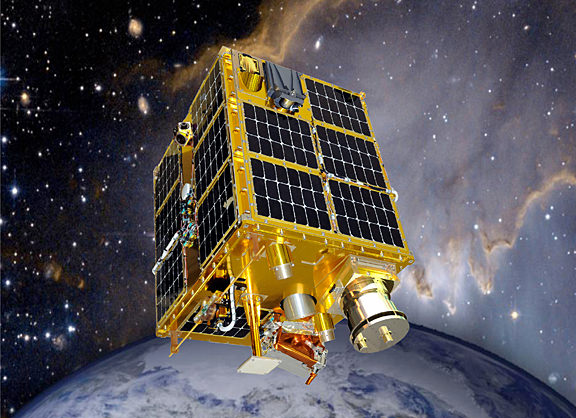[/caption]
While the U.S. Air Force unsuccessfully tried to get a Delta IV off the ground in Florida – things worked out far better for NASA at the Kodiak Launch Complex located in Kodiak, Alaska. Friday’s Minotaur 4 rocket launch successfully accomplished its mission of placing not one – but six satellites into orbit some 400 miles above the Earth.
The mission took off just before sunset from Launch Pad 1. After launch the $170 million flight turned southeast from its launch site going out over the Pacific Ocean. The launch took place under a clear sky with the moon lighting its way.
The payload for this flight was a rather mixed bag of NASA, military and university experiments. All six of the launch vehicle’s payloads were released right on time about 30 minutes after launch. The so-called ‘FASTSAT’ for Fast, Affordable, Science and Technology Satellite automatically switched itself on upon deployment. The project is a demonstration of ways to deploy experiments and other payloads cheaply and effectively to orbit.
Four of the satellites that were onboard the STP-S26 mission included the “ESPA-class:” STPSat-2, FalconSAT-5, FASTSAT-HSV01 and FASTRAC.
The FASTSAT program is NASA’s first microsatellite designed to provide multiple customers with access to orbit – at a lower cost. The main goal of the FASTSAT flight is to prove the viability of this capability to various government, academic and industry customers. The intent is to show that you do not have to invest millions of dollars into a single, large-scale satellite to conduct experiments on orbit.
The launch vehicle itself is also rather cheap as it is comprised of spare Peacekeeper missile tech. The STP-S26 mission was powered to orbit by a Minotaur IV launch vehicle, which was provided by the Rocket Systems Launch Program. The Minotaur IV is produced by Orbital Sciences Corporation.
One of the ‘firsts’ on this flight was the utilization of the Hydrazine Auxiliary Propulsion System (HAPS) to allow for dual-orbit capabilities. It is hoped, that in future flights this could be used to allow satellites to other orbits to give them far greater flexibility.
Another first employed on this mission was the first to use the Multi-Mission Satellite Operations Center Ground System Architecture. This center is capable of operating various satellites at the same time at a minimal cost. Indeed, the overriding theme of this launch would appear to be providing access to orbit – for less.


I’m surprised that it was launched from Alaska. Correct me if I’m wrong, but isn’t it preferable to launch from low latitudes (ie closer to the equator) to get an added boost from the faster rotational speed of the Earth? At the latitude of Kodiak Island, the rotational speed would be about 870km/h compared with approx 1670 at the equator.
Nice news
@ Paul
The intended orbit was a polar orbit, for which there is no particular benifit to having the launch site near the equator.
Clean launch. But Minotaur seems to fishtail a lot during ascent though.
“While the U.S. Air Force unsuccessfully tried to get a Delta IV off the ground in Florida – things worked out far better for NASA at the Kodiak Launch Complex located in Kodiak, Alaska.”
This was an Air Force mission too. NASA just hitched a ride.
This thing looks frightfully like a BORG cube :O